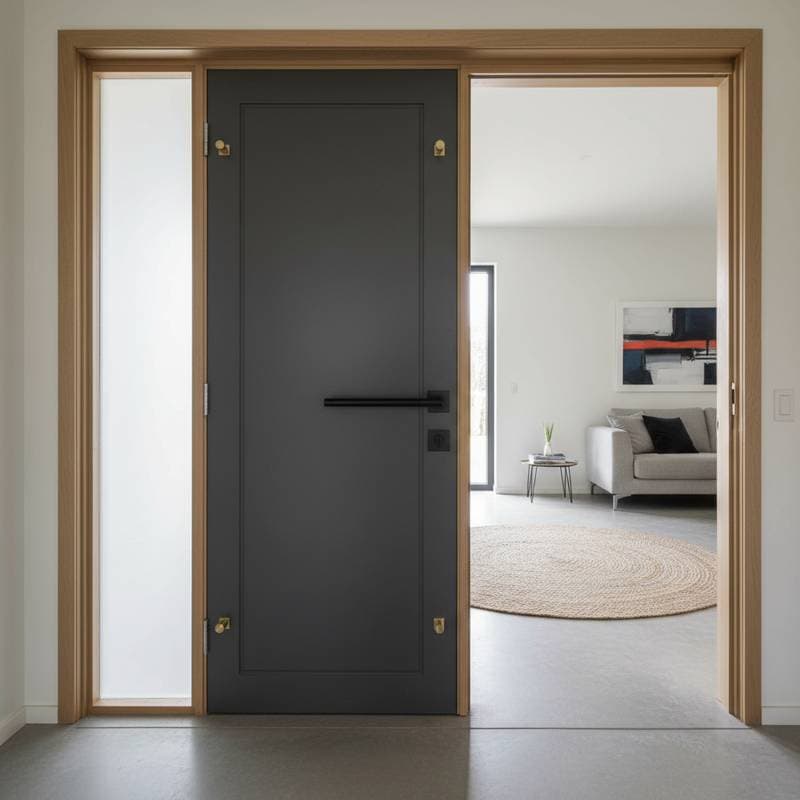Minimalist Tracks: The 2025 Barn Door Hardware Evolution
Barn doors have transformed from symbols of rustic farmhouse appeal to essential elements in minimalist interiors. This evolution emphasizes simplicity, precision, and subtle functionality that enhances luxury without overwhelming the space. The focus now lies on streamlined tracks, understated finishes, and seamless integration with architecture, creating doors that serve as intentional design features rather than decorative accents.
Achieving the Minimalist Aesthetic
Budget-Friendly Option ($300 to $800)
Select powder-coated steel hardware in matte black or soft white finishes. These options harmonize with light or dark doors while maintaining balanced visual proportions. Opt for a pre-assembled sliding kit featuring a concealed or slim track, which installs easily using standard tools. Allocate additional funds to the door panel, such as a smooth painted MDF or laminated veneer surface, to achieve a premium appearance on a limited budget.
Mid-Tier Option ($800 to $1,800)
Choose brushed aluminum or satin brass tracks to introduce an elevated yet accessible style. Incorporate soft-close mechanisms that eliminate noise and prolong hardware durability. Pair these with a solid-core wood door in natural oak or walnut stain, which introduces warmth and depth while preserving the emphasis on clean form.
Premium Option ($1,800 to $4,000)
Install recessed or fully concealed track systems that embed into ceiling channels or wall recesses. Combine with custom hardware in aged bronze or polished nickel for subtle elegance. Commission a tailored door from rift-cut oak, quarter-sawn ash, or lacquered paint, ensuring materials that endure and retain precise alignment over years.
Essential Materials and Finishes
For tracks and rollers, prioritize low-profile steel or aluminum designs with concealed fasteners. Matte, brushed, or anodized surfaces minimize reflections and align with minimalist environments.
Mounting plates should match wall colors to avoid disrupting sightlines. Installations in white-on-white or fixtures that echo nearby metals promote unbroken visual flow.
Handles and pulls favor simple rectangular shapes or recessed grooves to prevent excess detail. Blackened steel or brushed nickel options ensure enduring style.
Door panels consist of flat slabs in neutral painted tones or wood veneers with faint grain. These choices sustain a serene visual pace.
For trim and framing, eliminate casing for a flush installation where possible. If needed, use slim profiles with square edges in coordinating finishes.
Practical Maintenance Tips
Minimalist hardware demands consistent care to preserve its seamless operation. Clean tracks regularly with a dry microfiber cloth to remove dust that could hinder roller movement. Metal surfaces require gentle treatment; use a damp cloth followed by dry polishing to sustain luster without residue.
Apply silicone-based lubricant sparingly to soft-close components at pivot points to silence creaks and boost longevity. In coastal regions, select stainless steel or anodized aluminum to resist corrosion from salt exposure.
Clean painted doors with mild soap and water. Refresh waxed or stained wood using conditioner one to two times per season to preserve vibrancy.
Common Pitfalls to Avoid
Steer clear of ornate hardware like decorative straps or large wheels, which clash with minimalist principles. Select components that integrate into the structure rather than draw focus.
Ensure proper proportions by measuring the door to fit the opening, allowing at least two inches of overlap on each side for coverage and harmony.
Confirm wall stability before mounting; sliding tracks demand support from studs or reinforced anchors to bear the door weight securely.
Account for clearance in the sliding path, avoiding placements of switches or artwork that could obstruct motion.
Balance expenditures wisely; invest in durable rollers over flashy finishes to prevent premature failure.
Coordinating Colors and Styles
Minimalist barn doors thrive on controlled palettes that unify the space. Subtle variations set the tone without introducing chaos.
Recommended Color Options:
- Warm white, which fosters tranquility and amplifies light.
- Soft gray, ideal for pairing with aluminum or nickel elements.
- Charcoal black, providing depth with restraint.
- Natural oak, offering organic contrast to sleek lines.
- Dusty taupe, enhancing brass or bronze accents warmly.
Align these with wall and floor treatments. Light woods and white walls brighten areas, while deeper shades create coziness. Limit textures to maintain cohesion, such as pairing smooth walls with matte hardware and lightly grained doors.
Pre-Installation Photography Guide
Document your existing setup to inform decisions and aid professionals. This preparation clarifies proportions and potential challenges.
Homeowner Checklist:
- Photograph the full room to illustrate the door's relationship to walls and furniture.
- Detail current trim, casing, and floor junctions to predict fit issues.
- Note style elements like baseboard height or ceiling features that guide selections.
- Check community or building rules if the door faces outward.
- Measure door dimensions, height, and sliding clearance precisely.
- Outline budget focuses, prioritizing hardware or door quality.
Benefits of the Minimalist Track Design
This trend aligns with preferences for serene, streamlined living spaces. Discreet tracks allow architectural elements to stand out, positioning the door as an extension of the wall.
Such systems enhance open layouts by facilitating smooth room transitions. They also optimize small areas by reducing visual and physical obstruction, freeing floor space from swing paths. In contemporary settings with minimalist furnishings, these doors reinforce overall harmony.
Adapting to Regional and Climate Factors
Seal wood doors completely in humid areas to avert warping. Aluminum tracks outperform steel in moisture-prone zones like bathrooms or seaside locations.
In cold climates, solid-core insulated doors regulate temperatures across spaces. For busy areas such as kitchens, select heavy-duty hardware with nylon or polyurethane rollers to minimize noise and abrasion.
Arid regions benefit from UV-protective finishes on painted elements to combat sun damage.
Personalizing Your Installation
Minimalism accommodates personal touches through nuanced selections. A black track on a white wall generates subtle contrast, whereas matching tones evoke peace.
Incorporate custom recessed handles for individuality without excess. Blend textures, like matte tracks with glossy doors, for refined interest.
Weigh aesthetics against upkeep; concealed systems dazzle but may challenge fixes, while visible matched tracks simplify maintenance. This hardware embodies thoughtful design, blending form, function, and subtlety for enduring appeal.






